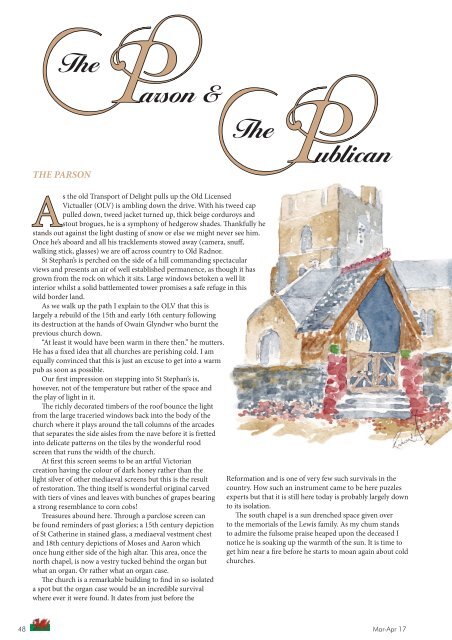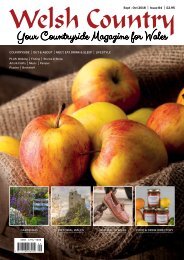Welsh Country March-April 2017
Create successful ePaper yourself
Turn your PDF publications into a flip-book with our unique Google optimized e-Paper software.
The P arson &<br />
The P ublican<br />
THE PARSON<br />
As the old Transport of Delight pulls up the Old Licensed<br />
Victualler (OLV) is ambling down the drive. With his tweed cap<br />
pulled down, tweed jacket turned up, thick beige corduroys and<br />
stout brogues, he is a symphony of hedgerow shades. Thankfully he<br />
stands out against the light dusting of snow or else we might never see him.<br />
Once he’s aboard and all his tracklements stowed away (camera, snuff,<br />
walking stick, glasses) we are off across country to Old Radnor.<br />
St Stephan’s is perched on the side of a hill commanding spectacular<br />
views and presents an air of well established permanence, as though it has<br />
grown from the rock on which it sits. Large windows betoken a well lit<br />
interior whilst a solid battlemented tower promises a safe refuge in this<br />
wild border land.<br />
As we walk up the path I explain to the OLV that this is<br />
largely a rebuild of the 15th and early 16th century following<br />
its destruction at the hands of Owain Glyndwr who burnt the<br />
previous church down.<br />
“At least it would have been warm in there then.” he mutters.<br />
He has a fixed idea that all churches are perishing cold. I am<br />
equally convinced that this is just an excuse to get into a warm<br />
pub as soon as possible.<br />
Our first impression on stepping into St Stephan’s is,<br />
however, not of the temperature but rather of the space and<br />
the play of light in it.<br />
The richly decorated timbers of the roof bounce the light<br />
from the large traceried windows back into the body of the<br />
church where it plays around the tall columns of the arcades<br />
that separates the side aisles from the nave before it is fretted<br />
into delicate patterns on the tiles by the wonderful rood<br />
screen that runs the width of the church.<br />
At first this screen seems to be an artful Victorian<br />
creation having the colour of dark honey rather than the<br />
light silver of other mediaeval screens but this is the result<br />
of restoration. The thing itself is wonderful original carved<br />
with tiers of vines and leaves with bunches of grapes bearing<br />
a strong resemblance to corn cobs!<br />
Treasures abound here. Through a parclose screen can<br />
be found reminders of past glories; a 15th century depiction<br />
of St Catherine in stained glass, a mediaeval vestment chest<br />
and 18th century depictions of Moses and Aaron which<br />
once hung either side of the high altar. This area, once the<br />
north chapel, is now a vestry tucked behind the organ but<br />
what an organ. Or rather what an organ case.<br />
The church is a remarkable building to find in so isolated<br />
a spot but the organ case would be an incredible survival<br />
where ever it were found. It dates from just before the<br />
Reformation and is one of very few such survivals in the<br />
country. How such an instrument came to be here puzzles<br />
experts but that it is still here today is probably largely down<br />
to its isolation.<br />
The south chapel is a sun drenched space given over<br />
to the memorials of the Lewis family. As my chum stands<br />
to admire the fulsome praise heaped upon the deceased I<br />
notice he is soaking up the warmth of the sun. It is time to<br />
get him near a fire before he starts to moan again about cold<br />
churches.<br />
48 Mar-Apr 17




